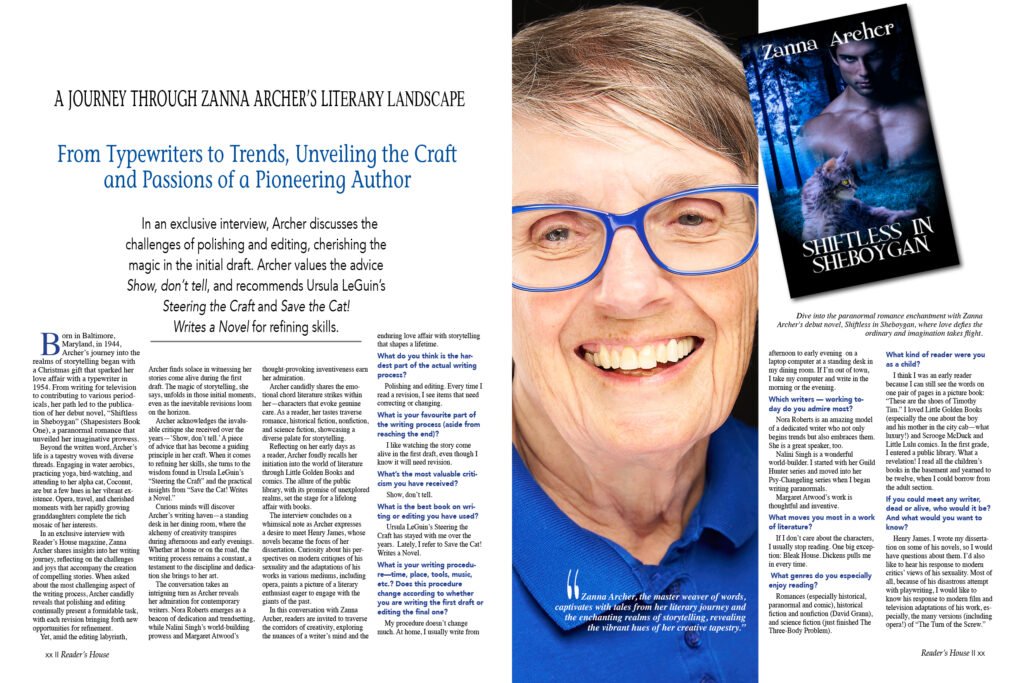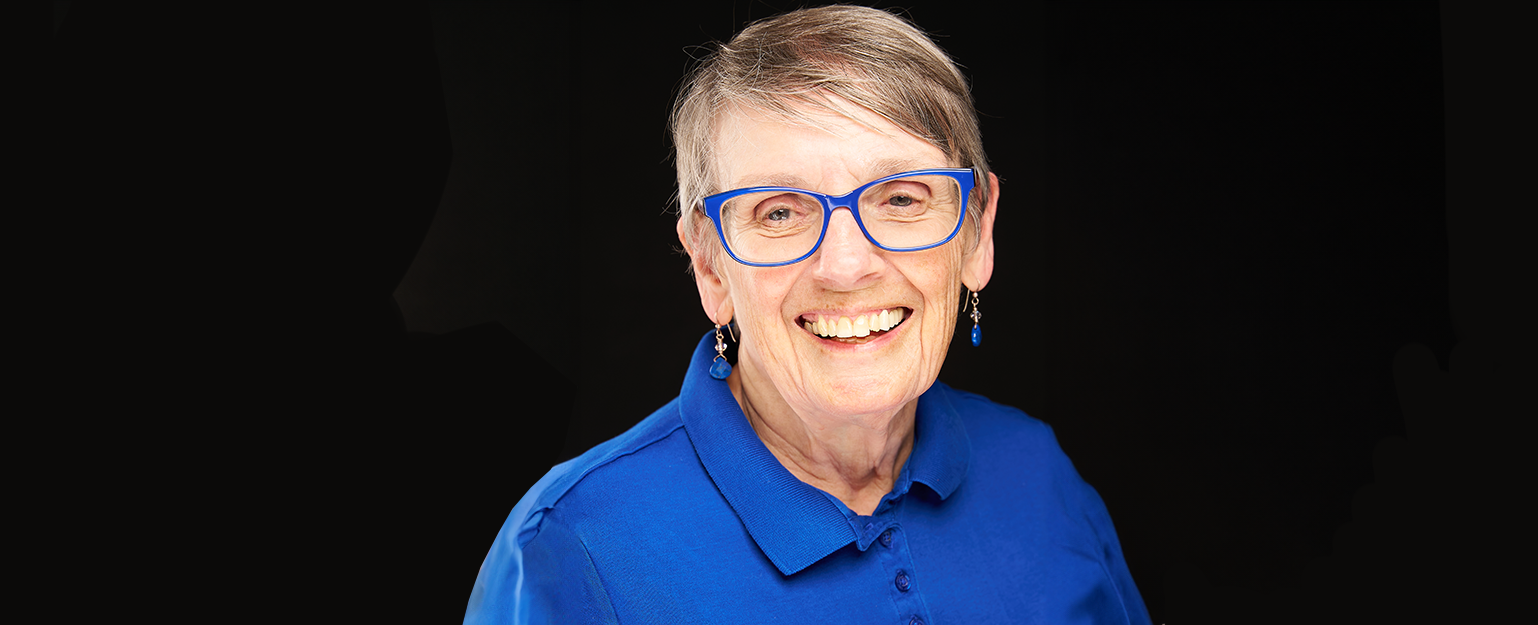From Typewriters to Trends, Unveiling the Craft and Passions of a Pioneering Author
Born in Baltimore, Maryland, in 1944, Archer’s journey into the realms of storytelling began with a Christmas gift that sparked her love affair with a typewriter in 1954. From writing for television to contributing to various periodicals, her path led to the publication of her debut novel, “Shiftless in Sheboygan” (Shapesisters Book One), a paranormal romance that unveiled her imaginative prowess.
Beyond the written word, Archer’s life is a tapestry woven with diverse threads. Engaging in water aerobics, practicing yoga, bird-watching, and attending to her alpha cat, Coconut, are but a few hues in her vibrant existence. Opera, travel, and cherished moments with her rapidly growing granddaughters complete the rich mosaic of her interests.
In an exclusive interview with Reader’s House magazine, Zanna Archer shares insights into her writing journey, reflecting on the challenges and joys that accompany the creation of compelling stories. When asked about the most challenging aspect of the writing process, Archer candidly reveals that polishing and editing continually present a formidable task, with each revision bringing forth new opportunities for refinement.
Yet, amid the editing labyrinth, Archer finds solace in witnessing her stories come alive during the first draft. The magic of storytelling, she says, unfolds in those initial moments, even as the inevitable revisions loom on the horizon.
Archer acknowledges the invaluable critique she received over the years—’Show, don’t tell.’ A piece of advice that has become a guiding principle in her craft. When it comes to refining her skills, she turns to the wisdom found in Ursula LeGuin’s “Steering the Craft” and the practical insights from “Save the Cat! Writes a Novel.”
Curious minds will discover Archer’s writing haven—a standing desk in her dining room, where the alchemy of creativity transpires during afternoons and early evenings. Whether at home or on the road, the writing process remains a constant, a testament to the discipline and dedication she brings to her art.
The conversation takes an intriguing turn as Archer reveals her admiration for contemporary writers. Nora Roberts emerges as a beacon of dedication and trendsetting, while Nalini Singh’s world-building prowess and Margaret Atwood’s thought-provoking inventiveness earn her admiration.
Archer candidly shares the emotional chord literature strikes within her—characters that evoke genuine care. As a reader, her tastes traverse romance, historical fiction, nonfiction, and science fiction, showcasing a diverse palate for storytelling.
Reflecting on her early days as a reader, Archer fondly recalls her initiation into the world of literature through Little Golden Books and comics. The allure of the public library, with its promise of unexplored realms, set the stage for a lifelong affair with books.
The interview concludes on a whimsical note as Archer expresses a desire to meet Henry James, whose novels became the focus of her dissertation. Curiosity about his perspectives on modern critiques of his sexuality and the adaptations of his works in various mediums, including opera, paints a picture of a literary enthusiast eager to engage with the giants of the past.
In this conversation with Zanna Archer, readers are invited to traverse the corridors of creativity, exploring the nuances of a writer’s mind and the enduring love affair with storytelling that shapes a lifetime.
What do you think is the hardest part of the actual writing process?
Polishing and editing. Every time I read a revision, I see items that need correcting or changing.
What is your favourite part of the writing process (aside from reaching the end)?
I like watching the story come alive in the first draft, even though I know it will need revision.
What’s the most valuable criticism you have received?
Show, don’t tell.
What is the best book on writing or editing you have used?
Ursula LeGuin’s Steering the Craft has stayed with me over the years. Lately, I refer to Save the Cat! Writes a Novel.
What is your writing procedure—time, place, tools, music, etc.? Does this procedure change according to whether you are writing the first draft or editing the final one?
My procedure doesn’t change much. At home, I usually write from afternoon to early evening on a laptop computer at a standing desk in my dining room. If I’m out of town, I take my computer and write in the morning or the evening.
Which writers — working today do you admire most?
Nora Roberts is an amazing model of a dedicated writer who not only begins trends but also embraces them. She is a great speaker, too.
Nalini Singh is a wonderful world-builder. I started with her Guild Hunter series and moved into her Psy-Changeling series when I began writing paranormals.
Margaret Atwood’s work is thoughtful and inventive.
What moves you most in a work of literature?
If I don’t care about the characters, I usually stop reading. One big exception: Bleak House. Dickens pulls me in every time.
What genres do you especially enjoy reading?
Romances (especially historical, paranormal and comic), historical fiction and nonfiction (David Grann), and science fiction (just finished The Three-Body Problem).
What kind of reader were you as a child?
I think I was an early reader because I can still see the words on one pair of pages in a picture book: “These are the shoes of Timothy Tim.” I loved Little Golden Books (especially the one about the boy and his mother in the city cab—what luxury!) and Scrooge McDuck and Little Lulu comics. In the first grade, I entered a public library. What a revelation! I read all the children’s books in the basement and yearned to be twelve, when I could borrow from the adult section.
If you could meet any writer, dead or alive, who would it be? And what would you want to know?
Henry James. I wrote my dissertation on some of his novels, so I would have questions about them. I’d also like to hear his response to modern critics’ views of his sexuality. Most of all, because of his disastrous attempt with playwriting, I would like to know his response to modern film and television adaptations of his work, especially, the many versions (including opera!) of “The Turn of the Screw.”
An Excerpt from Shiftless in Sheboygan
Tall, dark, and indecently handsome, he looked like he owned the whole damned hotel, restaurant included. He bestowed smiles on every female he encountered. From grandma to teenager, server to customer, they looked ready to fall into those long arms swathed in the charcoal gray sleeves of a well-tailored suit. Despite the smile, he moved like a predator. Even from a distance, Steffi’s skin prickled beneath his power.
In a few long strides, he stood at her table. “Miss Anbruzzen?”

Follow the Author
- web: https://zannaarcher.com
- Amazon Author page: https://www.amazon.com/stores/Zanna-Archer/author/B09X4MDMKG?ref=ap_rdr&store_ref=ap_rdr&isDramIntegrated=true&shoppingPortalEnabled=true
- Goodreads Author page: https://www.goodreads.com/author/show/22574887.Zanna_Archer?from_search=true&from_srp=true
- Facebook: https://m.facebook.com/zannaarcher
- – Twitter: https://twitter.com/ZannaArcher

is presented to Ms. Archer
and a select group of exceptional authors
by The Reader’s House magazine.

Click image to enlarge.


